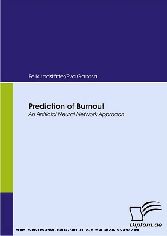Suchen und Finden
Prediction of Burnout. An Artificial Neural Network Approach
This Study about burnout in nurses takes a different approach than all prior empirical work on this topic given that nonlinear relationships between job stressors, personal factors and the three burnout dimensions are investigated using artificial neural networks, a type of computer simulation that is especially well suited to capturing nonlinearities in data.
The burnout process is related to organizational, personal, interpersonal, social, and cultural variables and these relationships are not exclusively linear. Due to this nonlinearity, hierarchical stepwise multiple regression or other linear statistical methods, may perhaps not be the most suitable method to analyze the data effectively. Compounding the dilemma is that multiple linear regression returns no direct indicator with regard to whether the data is best portrayed linearly. In standard least squares linear regression, the model has to be specified previously and assumptions have to be made concerning the underlying relationship between independent variables and dependent variables. Since by default, the relationship is often assumed to be linear, the regression line can be erroneous even though the error of the fit can be small. Artificial neural networks do not have these limitations with nonlinearities and are therefore predestined for the analysis of nonlinear relationships.
This study is a complex research of burnout that includes socio-demographic characteristics, job stressors, and hardy personality. Typically, studies on burnout have investigated primarily the effects of organizational factors. Recently, authors revealed and confirmed the important effects of personality variables on the burnout process.
The objective of developing an instrument to predict burnout (NuBuNet abbreviation for Nursing Burnout Network) in nurses is accomplished by using two different types of artificial neural networks: A three-layer feed-forward network with the gradient decent back-propagation training algorithm and a radial basis function network with two different training algorithms: the pseudo inverse algorithm and a hybrid algorithm.
The implementation of the artificial neural networks used in this study is carried out in a MATLAB® development environment. Instead of writing each artificial neural network as a stand-alone program, an object-oriented programming style is chosen to include all functions into one single system. Three artificial neural networks are implemented in the technical part of this study. A self-organizing map, a three-layer back-propagation network, and a radial basis function network. Whereas the self-organizing map is only used in the data preparation process, the back-propagation network and the radial basis function network is used in the burnout model approximation.
After an exhaustive training and simulation session including more than 150 networks and an analysis of all results, the network with the best results is chosen to be compared to the hierarchical stepwise multiple regression.
The network paradigms are better suited for the analysis of burnout than hierarchical stepwise multiple regression. Both can capture nonlinear relationships that are relevant for theory development. At predicting the three burnout sub-dimensions emotional exhaustion, depersonalization, and lack of personal accomplishment however, the radial basis function network is slightly better than the three-layer feed-forward network.
Alle Preise verstehen sich inklusive der gesetzlichen MwSt.









